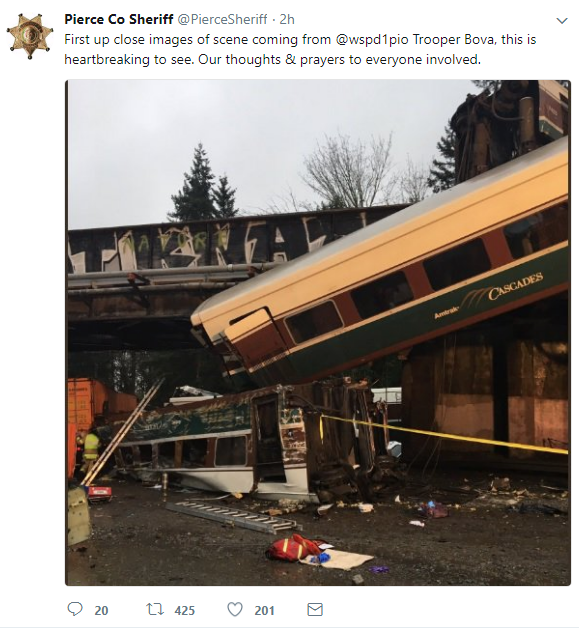Tragic Amtrak Wreck in Washington
Another tragedy on an AMTRAK train has caused the loss of lives and serious injuries in Dupont, Washington this morning. There are reports the train, the Cascades service from Seattle to Portland was travelling on tracks rated at a maximum speed of 79 mph, while the Cascades was reported to have been travelling at 80 miles per hour and the speed limit at the curve was limited to 30 miles per hour. The tracks had been slated for an upgrade to allow higher speeds, but had not been started yet.
On board the train were 75 souls when the train wrecked. A passenger, Chris Karnes, reported that passengers had to kick out windows because the emergency doors did not function properly. Mr. Karnes reported:
“We had just passed the city of DuPont and it seemed like we were going around a curve,” Karnes said. “All of a sudden, we felt this rocking and creaking noise, and it felt like we were heading down a hill. The next thing we know, we’re being slammed into the front of our seats, windows are breaking, we stop, and there’s water gushing out of the train. People were screaming.”
In a later recording of the engineer’s call to AMTRAK indicates they were negotiating the curve in the tracks and went off the tracks, off the bridge passing over highway I-5, near mile post 20:
“Amtrak 501, Emergency, emergency, emergency. We are on the ground!” the engineer stated. “We are on the bridge [inaudible] on the freeway. We need EMS ASAP. It looks like they’re already starting to show up.”
Curves present a special problem for trains, particularly when they are travelling at higher speeds. The curves in a track must be carefully engineered and the radius of curve must correspond to the expected use speed. The length of trains being operated on the track also significantly affects curve radii and overall track construction. Centrifugal force causes tilt in the train as it navigates curves; the length and severity of the curve must be engineered to accommodate the size and speed of trains. A train travelling 80 miles per hour into a curve rated at 30 miles per hour loses the force holding it to the track and the following trains can not maintain contact with the track; they will, as here, derail.
Our firm has done battle with AMTRAK and CSX Corporation. In one sad case, a decision to save money resulted in the tragic death of Paul Palank, leaving his wife widowed and two young children to grow up without their father. In that case, part of the train crash resulted from the railroad company trying to save by deferring maintenance of the tracks. The investigation of this derailment quickly focused on a faulty switching mechanism on the CSX rails. As the investigation continued, the appearance of neglect and decay on this area of track became evident. Several railroad experts have testified that the switch in question had been left in a defective condition for at least seven months.
The battle on behalf of Angel Palank and her children resulted in verdicts of over $56 million; but that did nothing to bring back father and husband.
Later, on April 18, 2002 in Crescent City, FL, , the Amtrak Auto Train P052-18 passed over a buckled portion of the track, 21 of its 40 cars derailed and careened off the tracks resulting in catastrophic passenger and crew injuries, and four passenger deaths. Chris Searcy and Greg Barnhart from our firm, because of extensive experience with train derailments, were able to successfully obtain justice for 11 injured and killed passengers for a tragedy that should never have happened.
With the AMTRAK train 501, on the Cascades service in Washington state, it derailed on an overpass and reports indicate that motorists travelling below the train tracks were also injured because of the derailment and at least one car plummeting down to the highway. It will require an experienced and in-depth investigation to determine the root cause of this very tragic train derailment. The investigation of train derailment is a complex area filled with industry experience, engineering standards, the science of metallurgy and detailed industry regulation standards. The rules and standards are there for a reason and following them saves lives; violating them can often result in the tragic loss of life.
In this Cascades line crash emergency teams seem to have moved rapidly and triage tents have been set up at the scene of the train accident, but the last report indicated that approximately 77 people were being transported to area hospitals, including St. Josephs Medical Center, St. Clare Hospital, St. Anthony Hospital, and Tacoma General Hospital. That quick, competent reaction time by rescue workers probably have saved lives and diminished injuries.
We should all say a few words of prayer that fatalities are few and injuries are not severe.
Share This



